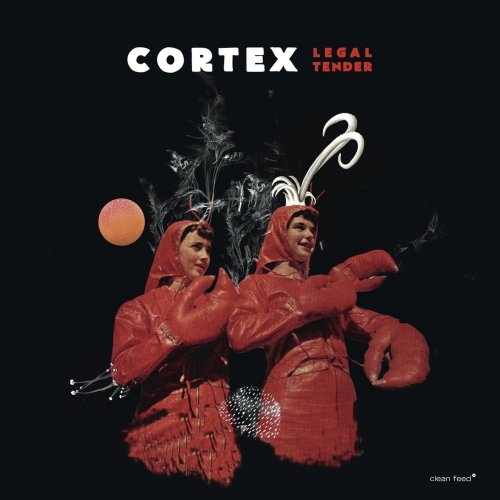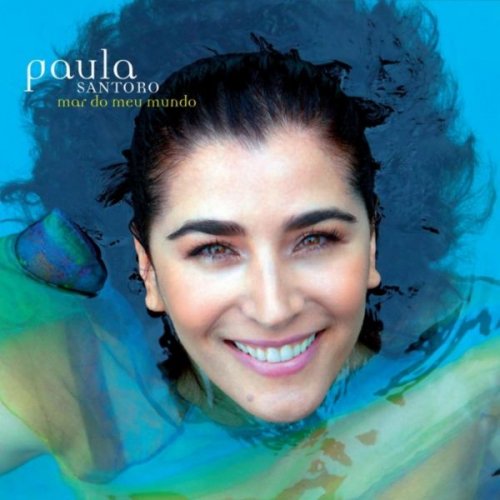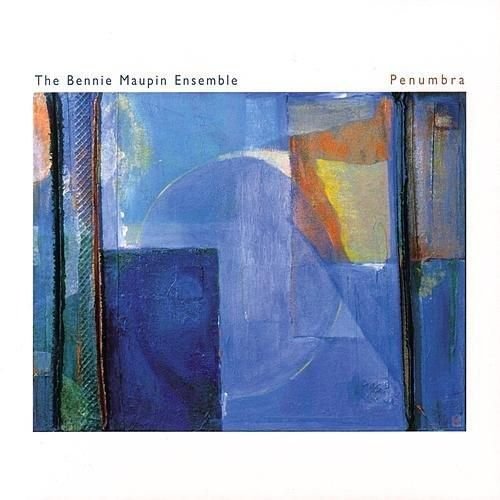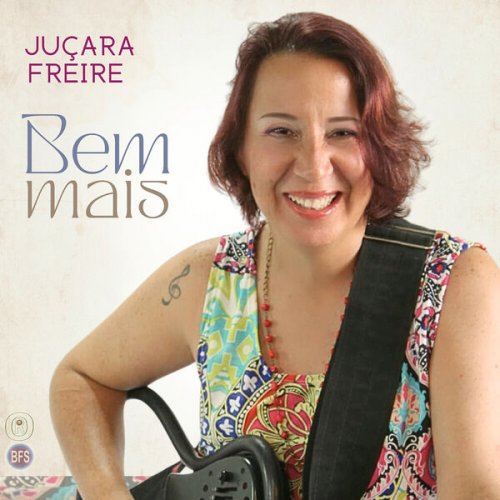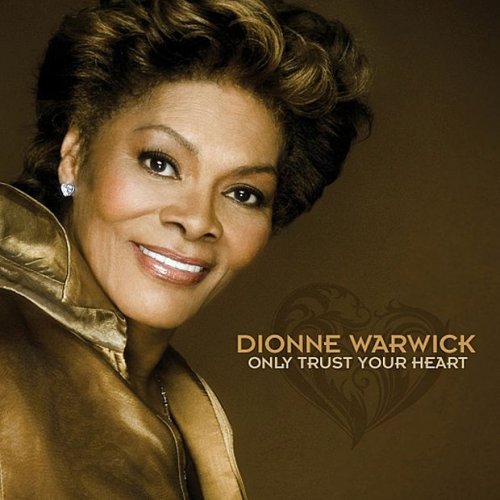Charlie Gracie - It's Fabulous (1995)
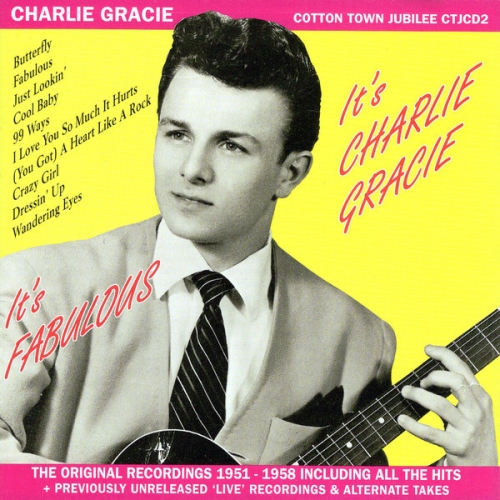
Artist: Charlie Gracie
Title: It's Fabulous
Year Of Release: 1995
Label: Cotton Town Jubilee
Genre: Rock & Roll, Rockabilly
Quality: Flac (image, .cue, log)
Total Time: 01:11:38
Total Size: 389 Mb (scans)
WebSite: Album Preview
Title: It's Fabulous
Year Of Release: 1995
Label: Cotton Town Jubilee
Genre: Rock & Roll, Rockabilly
Quality: Flac (image, .cue, log)
Total Time: 01:11:38
Total Size: 389 Mb (scans)
WebSite: Album Preview
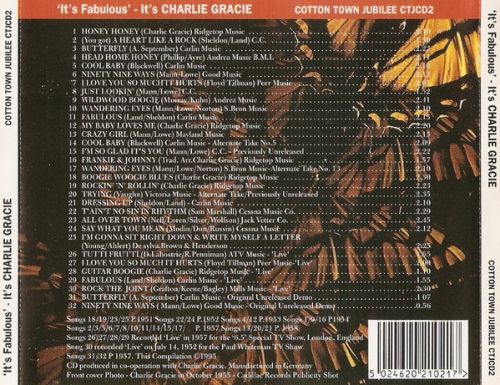
Tracklist:
01. Honey Honey
02. (You Got) A Heart Like a Rock
03. Butterfly
04. Head Home Honey
05. Cool Baby
06. Ninety Nine Ways
07. I Love You So Much It Hurts
08. Just Lookin'
09. Wildwood Boogie
10. Wandering Eyes
11. Fabulous
12. My Baby Loves Me
13. Crazy Girl
14. Cool Baby
15. I'm So Glad It's You
16. Frankie and Johnny
17. Wandering Eyes
18. Boogie Woogie Blues
19. Rockin' 'N' Rollin'
20. Trying
21. Dressing Up
22. T'Ain't No Sin in Rhythm
23. All Over Town
24. Say What You Mean
25. I'm Gonna Sit Right Down and Write Myself a Letter
26. Tutti Frutti
27. I Love You So Much It Hurts
28. Guitar Boogie
29. Fabulous
30. Rock the Joint
31. Butterfly
32. Ninety Nine Ways
Charlie Gracie was Philadelphia's first rock & roll star, the first successful artist on that city's famed Cameo Records, an early regular on American Bandstand, and a skilled rockabilly-style guitarist. He is best known for the 1957 hit single "Butterfly," which rose to number one on the Billboard charts. His popularity was also significant in the U.K. and his lingering influence there is such that his praises have been sung by the likes of Paul McCartney (who covered "Fabulous," one of Gracie's early recordings), George Harrison, Van Morrison and Graham Nash.
Born May 14, 1936 (the same day as Bobby Darin), with his surname originally spelled "Graci", Charlie Gracie grew up in South Philadelphia, listening to country music and big-band jazz. At age 10, he obtained his first guitar, and by 15 he was a prodigy, performing regularly and winning contests on the simulcast radio and television show of early jazz great Paul Whiteman. Signed first to Cadillac Records, Gracie's first single, "Boogie-Woogie Blues," recorded in 1951, was not a hit, nor were a couple of follow-ups for other labels. Then, in 1956, he was signed to the fledgling Cameo label. Gracie's first recording consisted of two songs written by the label's co-owners, Bernie Lowe and Kal Mann, "Butterfly" and "Ninety-Nine Ways." With repeated appearances on American Bandstand, hosted by Dick Clark, as well as The Ed Sullivan Show and other TV programs of the day, Gracie's popularity soared, and by April 1957, "Butterfly" had reached number one in the States. ("Butterfly" also became a chart-topper for crooner Andy Williams the same year.) Gracie's style was not as raucous as fellow early guitar rockers such as Gene Vincent or Eddie Cochran, but he made up for any loss of grit with an undeniable professionalism and easy likeability. Gracie's guitar style has been described as a mix of rockabilly, jump blues, swing, and country boogie, while his vocals incorporate pop, blues, R&B, and rock & roll influences.
Another Mann-Lowe composition, "Fabulous" followed "Butterfly" in the spring of 1957, reaching number 16 in the U.S. and number eight in the U.K. Gracie subsequently toured the U.K. -- the first solo American rock & roller to do so -- headlining at the Hippodrome Theater. He scored only one further hit in America, "I Love You So Much It Hurts," written by country singer Floyd Tillman, which only reached number 71 (although it reached number 14 in the U.K.). His biggest hit in England was yet to come, "Wanderin' Eyes," which reached number six there, and he logged his final U.K. hit with "Cool Baby." Gracie continued to record for Cameo into 1958, when he had a falling out with Lowe. Clark no longer booked him on his program after that, and Gracie faded from the charts. He recorded for several other labels into the '60s, including Coral and Roulette, and has continued to perform regularly both near Philadelphia and in Europe, where the rockabilly revival kept his popularity high for decades. Gracie was still going strong into the first decade of the 21st century. His Cameo catalog remained unavailable on CD for many years, until the ABKCO label released a compilation in 2006. In 2007, a documentary film chronicling Gracie's story Fabulous, was aired on PBS stations.
Born May 14, 1936 (the same day as Bobby Darin), with his surname originally spelled "Graci", Charlie Gracie grew up in South Philadelphia, listening to country music and big-band jazz. At age 10, he obtained his first guitar, and by 15 he was a prodigy, performing regularly and winning contests on the simulcast radio and television show of early jazz great Paul Whiteman. Signed first to Cadillac Records, Gracie's first single, "Boogie-Woogie Blues," recorded in 1951, was not a hit, nor were a couple of follow-ups for other labels. Then, in 1956, he was signed to the fledgling Cameo label. Gracie's first recording consisted of two songs written by the label's co-owners, Bernie Lowe and Kal Mann, "Butterfly" and "Ninety-Nine Ways." With repeated appearances on American Bandstand, hosted by Dick Clark, as well as The Ed Sullivan Show and other TV programs of the day, Gracie's popularity soared, and by April 1957, "Butterfly" had reached number one in the States. ("Butterfly" also became a chart-topper for crooner Andy Williams the same year.) Gracie's style was not as raucous as fellow early guitar rockers such as Gene Vincent or Eddie Cochran, but he made up for any loss of grit with an undeniable professionalism and easy likeability. Gracie's guitar style has been described as a mix of rockabilly, jump blues, swing, and country boogie, while his vocals incorporate pop, blues, R&B, and rock & roll influences.
Another Mann-Lowe composition, "Fabulous" followed "Butterfly" in the spring of 1957, reaching number 16 in the U.S. and number eight in the U.K. Gracie subsequently toured the U.K. -- the first solo American rock & roller to do so -- headlining at the Hippodrome Theater. He scored only one further hit in America, "I Love You So Much It Hurts," written by country singer Floyd Tillman, which only reached number 71 (although it reached number 14 in the U.K.). His biggest hit in England was yet to come, "Wanderin' Eyes," which reached number six there, and he logged his final U.K. hit with "Cool Baby." Gracie continued to record for Cameo into 1958, when he had a falling out with Lowe. Clark no longer booked him on his program after that, and Gracie faded from the charts. He recorded for several other labels into the '60s, including Coral and Roulette, and has continued to perform regularly both near Philadelphia and in Europe, where the rockabilly revival kept his popularity high for decades. Gracie was still going strong into the first decade of the 21st century. His Cameo catalog remained unavailable on CD for many years, until the ABKCO label released a compilation in 2006. In 2007, a documentary film chronicling Gracie's story Fabulous, was aired on PBS stations.

![The Baroque Jazz Ensemble - The Baroque Jazz Ensemble (feat. Ira Schulman) (2025) [Hi-Res] The Baroque Jazz Ensemble - The Baroque Jazz Ensemble (feat. Ira Schulman) (2025) [Hi-Res]](https://img.israbox.com/img/2025-12/19/yehoqbmzkuwk180c26lz85clx.jpg)
